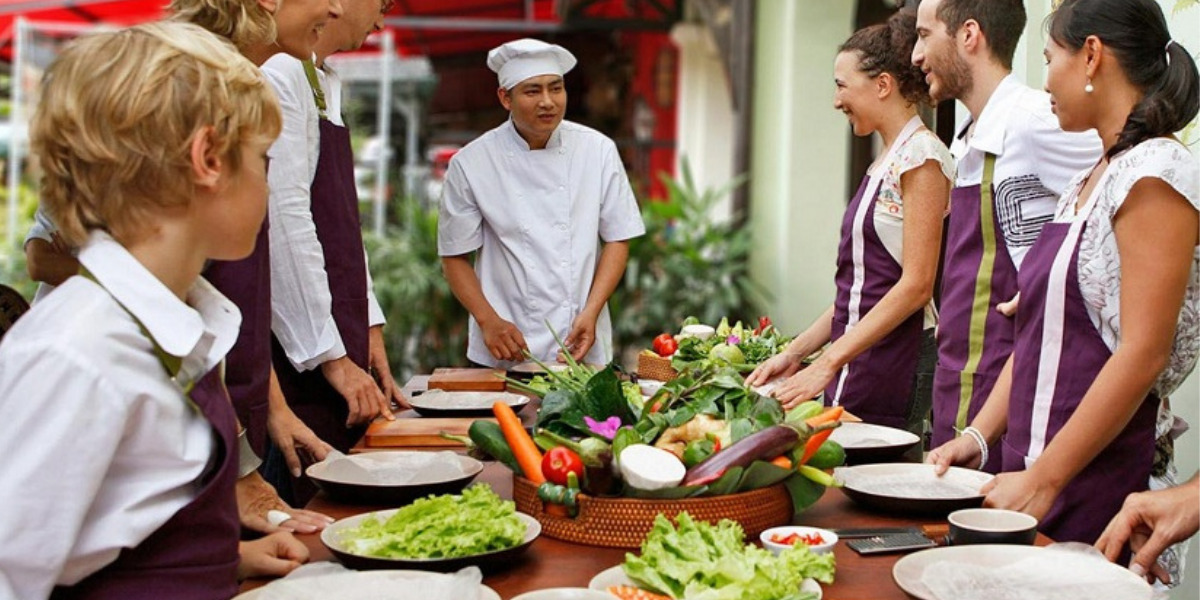If you want to have an insight into the culture and tradition of Vietnam, rural areas are way more suitable than urban areas. The countryside in Vietnam is associated with a thin population, strong bond between neighbors, primitive transport, and an agrarian economy. Even though there are some changes in the modern way due to the influence of industrialization and modernization, all the finest values are well preserved and passed down from generation to generation.
I - How is life in Vietnamese countryside?
1 - Population
According to the results of the 2019 Census on Population and Housing in Vietnam, there are 63 million people living in the countryside, accounting for 65.4% of the national population. However, the component is dominated by children and the old. Young adults and people of working age mostly move toward big cities to pursue tertiary education, search for a job or go abroad as migrant workers.
People from the Vietnamese countryside who can survive in the vibrant city life often decide to settle down there and come back just a couple of times per year on special occasions such as Tet holiday, weddings, funerals, anniversaries of family members’ death… while those working in a foreign countries return home only when they have earn quite of large sum of money.
2 - Culture of the Vietnamese countryside
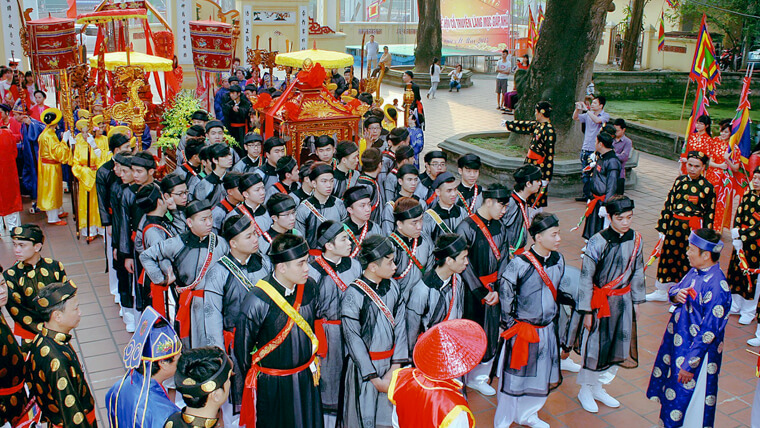
A village festival - Source: thanhxuan.hanoi.gov.vn
Conventionally, Vietnamese people stayed close to each other both in distance and in mind, which can be still clearly seen in most villages nowadays. Vietnamese people have one saying “Better a neighbor near than a brother far off”. Households in the countryside of Vietnam cluster together into villages. Homes are ambiguously separated by low, simple fences and walls. People cohabit in harmony. They share everything with each other, lay trust in each other, and are ready to offer support without waiting for a request. Therefore, the crime rate is very low in this section.
Unlike the city, there are a variety of big and small festivals annually in the Vietnamese countryside. These are occasions for the local folks to show their respect to gods, saints, heroes, who gave them a peaceful life. Therefore, every stage before, during, and after the events are carefully planned by the whole community, from the young to the old, both male and female join hands to accomplish the work. Carrying out a successful ceremony is also the way they take pride in the tradition of the homeland.
3 - Means of transport in the countryside in Vietnam
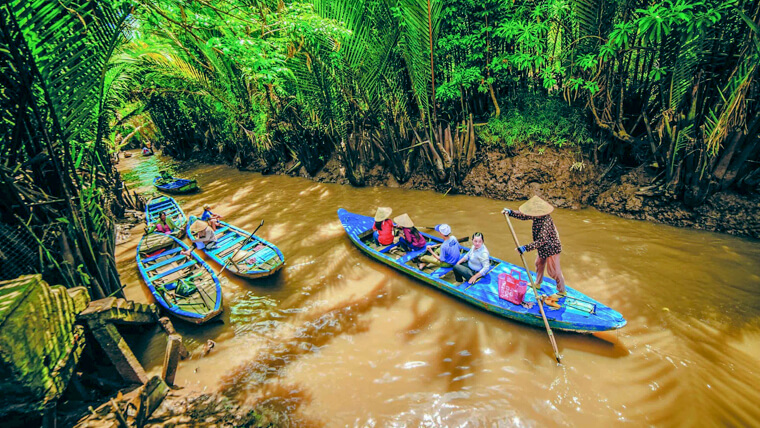
Boat is very popular in the Mekong Delta in Vietnam - Source: wall.vn
Each locality has its main ways to travel within the area. For example, in rural areas of plains and deltas in the North and the Central of Vietnam, most residents go by bicycle or types of ox and buffalo carts. Commonly used to carry rice and food from the fields, carts are loved and developed because almost every household raises cows or buffaloes. In addition, in the Vietnamese countryside of Phu Yen province, people still use horse-drawn carriages to travel and carry goods, making it a unique beauty of this area. Dwellers in the countryside of the Northwest area go on foot or use carts due to the mountainous terrain, while the major means of transport in the Mekong Delta is boats such as bamboo or basket because people often travel on rivers and canals.
At the same time, people in the countryside of Vietnam also use tractors or plows to travel, not only convenient to go to the fields but also to go outside of the village. With the development of roads and the improvement of people's living standards, motorbikes are also a means of transport used by many people, which is more convenient but also pollutes the environment. Not to mention, many people are still used to the way of travel indiscriminately, according to their will, without following any rules while using a motorbike.
4 - How do people in the Vietnamese countryside earn a living?
In the past, life in the Vietnam countryside was mostly based on rice fields, handicrafts and fishing - a self-sufficient economy. Families can either produce on their own or trade for the products they need to satisfy their basic needs, such as food or clothing. The goods exchanged in the village market are often “leftovers”, so when they want to buy something out of the ordinary, people would go to the provincial market.
In recent years, clean water and electricity have been accessed all over the country, making life in the countryside in Vietnam a lot easier. Thanks to the development of technology and the restructuring of regions, supermarkets, trade centers, and many factories have been built in the rural areas. While there are people who have developed towards more modern agriculture, many more have left the fields completely to work in factories. At the same time, many villages are now also focusing on developing tourism, making it a major source of income no less than agriculture or industry.
II - Top 7 worth-visiting Vietnamese countrysides
1 - Bat Trang ceramic village - the best countryside in Vietnam
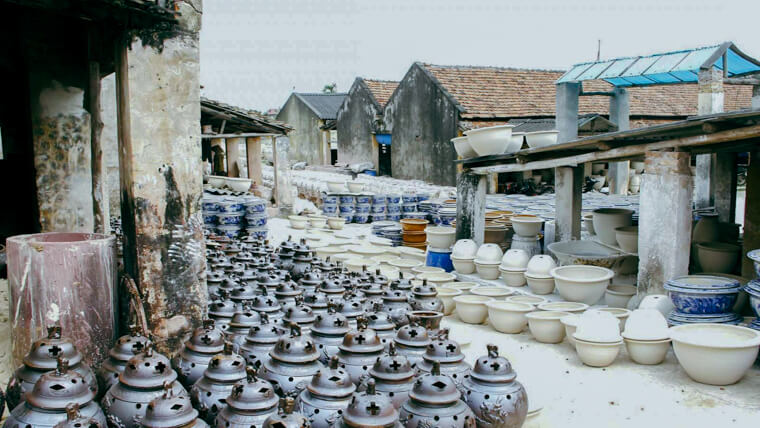
A corner of Bat Trang village - Source: vietnamairline
Worthy of being the first name on this list, Bat Trang ceramic village is located in Gia Lam District, on the outskirts of Hanoi, only about 10km from the center of the capital. Over hundreds of years of existence and development, the villagers have both preserved the local traditional craft and adapted to the trend of the times. Stepping into Bat Trang, you can easily see the precious traditional cultural features shown from the local houses, village gates, stone pillars, and so on, to moss-covered walls, ceramic drying racks, etc, and feel a typical peaceful life in Vietnamese countryside. On both sides of the road to the village market, there are many products on display, which of high artistic value that are made with great enthusiasm of the craftsmen. Some are freshly molded raw pottery, some have been fired to a glossy brown color, and some are already brightly colored.
The most interesting thing when traveling to this Vietnam countryside is that you will have the opportunity to not only observe the artisans meticulously shaping and decorating each product made of ceramic and porcelain, but also try it yourself. After visiting the market, you can register to play with pottery at the gate and feel free to create anything with the ceramic turntable. The artisans will guide you through the process of shaping and prototyping, even help you with the firing process after you finish shaping the product. The price of making pottery is about 10,000 VND / time ($0.44) and an additional 40,000 - 60,000 VND ($1.76 - 2.64) for firing.
2 - Cat Cat village - a worth-visit Vietnamese countryside
Located in San Sa Ho village - about 2km from Sapa town center, Cat Cat village features characteristics of the mountainous countryside in the Northeast of Vietnam. Visiting here, you will be enchanted by the wild and majestic nature, wooden stilt houses, narrow rocky roads and stalls filled with handicrafts and brocades. Despite being a tourist attraction, there is no sign of materialism or artificialization. Spending a couple of days in the countryside of Vietnam, you will get used to the customs and cuisine of the H’mong people (an ethnic group in Vietnam).
Ticket prices: 70,000 VND / adult ($3.08) & 30,000 VND / child ($1.32)
3 - Lac village
Only about 140km from Hanoi, Lac village in Mai Chau District, Hoa Binh Province is a striking place for those who would like to experience the life of the Vietnamese countryside. Living in stilt houses with thatched roofs 2m above the ground, residents here rely mainly on brocade weaving and shifting cultivation.
Since the beauty of the village is known, tourists flock here to see the scenery and experience the peaceful life of the countryside in Vietnam, making the idea of community tourism flourish. The locals remodel their houses on stilts, improving them with new materials to make it more secure for tourists. Although focusing on community tourism, they still maintain their natural landscape, customs, habits and lifestyle, retaining their traditional beauty in modern times.
Currently, in Lac village, there are more than 20 spacious motels and homestays that you can choose from, but it is recommended that you stay in a stilt house. During your stay in this Vietnamese countryside, there are also many interesting experiences that you can try including participating in activities and group exchanges such as camping, making a campfire… You can also rent a bicycle to explore around the village, visit the Chieu cave located not far away, or immerse yourself in the green space of rice fields spreading out over the horizon. In addition to enjoying specialties such as Lam rice or hill chicken, walking around the market and buying brocade products as souvenirs for your loved ones are also not bad choices.
4 - Mui Ne village - an ideal place to enjoy the vibes of the Vietnamese countryside
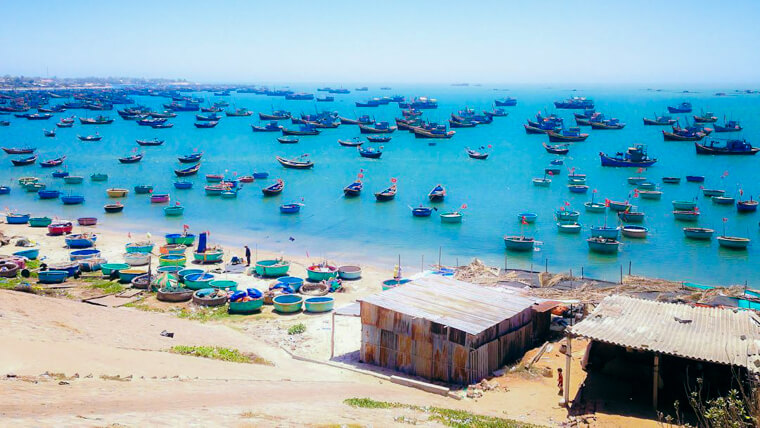
Mui Ne fishing village - Source: doicattrang.com
Experiencing rural life in a fishing village like Mui Ne, to better understand the daily life of fishermen is also an interesting idea. This village is located on Huynh Thuc Khang street, between Mui Ne and Ham Tien wards, in Phan Thiet City, Binh Thuan province. Visiting this countryside in Vietnam, you can witness the hectic atmosphere at about 5 to 6 am when fleets of ships bringing a great amount of seafood arrive on the coast and people gather to sort fish into different baskets. Standing out in the vast space of the sea and sky are the colorful basket boats floating on the deep blue water and the shadows of people exchanging and trading on the white sandy beach.
You can freely buy fresh, cooked, or raw seafood at cheap prices in tents along the beach or at the market inside the fishing village of Mui Ne. This Vietnamese countryside is also known for hand-crafted dry cuisine ranging from fish to regular and spicy squid, and the famous Nhi fish sauce Phan Thiet. You should go deep into the village to explore the stages to produce these specialties and directly buy some as gifts yourself.
In recent years, an increasingly popular activity in this countryside in Vietnam is kayaking to experience and explore the sea at dawn or dusk, blending into the peaceful natural space. Sitting on a small kayak, you do not have to watch from afar, but beautiful basket boats, fishermen engrossed in nets and undulating waves appear right in front of your eyes.
5 - Cam Thanh eco-village
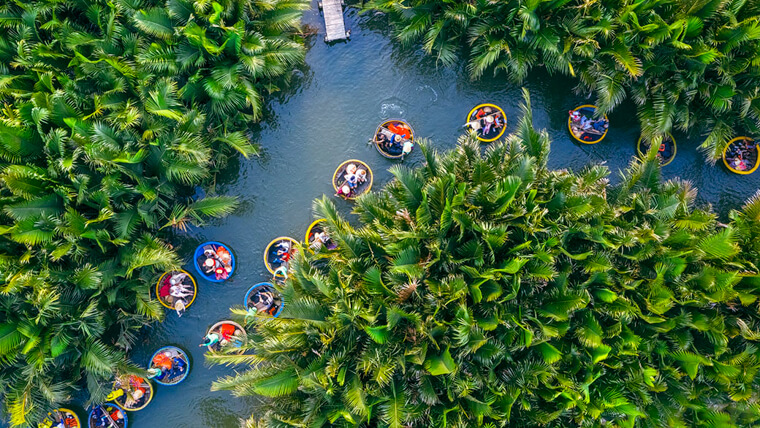
Tourists at Cam Thanh village - Vietnam countryside pictures - Source: vinpearl
From Hoi An ancient town, it only takes a couple of minutes to sail on the Thu Bon river to the east to reach Cam Thanh ecological village. A highlight of this Vietnamese countryside is the endless coconut forest, which is not only a green lung of the city but also a mangrove ecosystem with a diversity of brackish water plants and animals. You can rent a bicycle to wander around the village, immerse yourself in the beautiful and idyllic space of the vast rice fields and breathe in the countryside air filled with the scent of ripe rice on your trip to this countryside of Vietnam. If you are tired of staying on land, this is the time for you to sit on a basket boat and enjoy the river space lined with coconut trees on both sides. On this trip, you will encounter the beautiful and intense basket boats dance, and the skillful releasing fishing nets of the fishermen here.
You will also have the opportunity to grow vegetables, catch fish, plow in the fields, and ride buffalo like a real farmer. Just spending a day here is enough for you to understand more about the Vietnamese countryside.
- Entrance ticket: 30,000 VND / person ($1.32)
- Renting a basket boat: 150,000 - 200,000 VND / boat ($6.6 - 8.8)
6 - Tan Lap floating village - a promising countryside in Vietnam
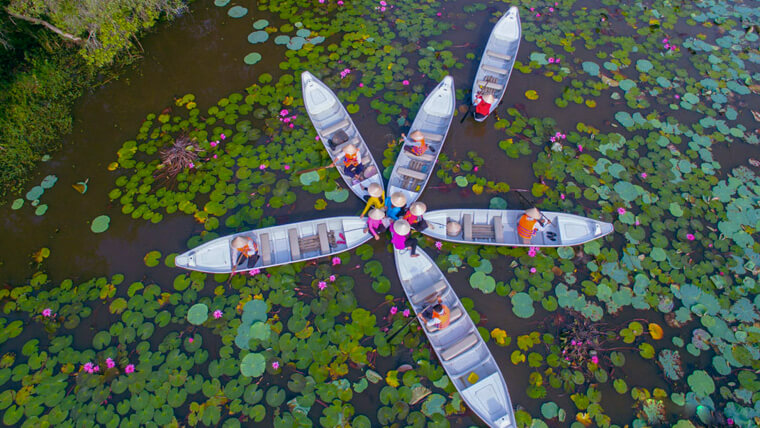
Tan Lap floating village - Source: tuongtaccongdong.com
If you are wondering about the countryside scene in South Vietnam, let’s pay a visit to Tan Lap floating village eco-tourism area in Moc Hoa district, Long An province. This is an area with a complex river system, where you will feel the taste of the countryside of Vietnam when you sit on a bamboo boat to explore every corner of the Melaleuca forest with the wild nature of the mangrove area. If you come in the right lotus blooming season from October to November, you can also visit the beautiful lotus lagoon area, with pink and purple lotus flowers dotted among the lush green space of the forest.
- Entrance fee: 60,000 VND / ticket ($2.64)
- Renting a boat: 30,000 VND / ticket ($1.32)
7 - Visiting the orchards to experience Vietnamese countryside life
In your Vietnam countryside tours, it must be a great pity if you miss the orchards in the Mekong Delta. The Mekong Delta in Vietnam has long been referred to as a green and fertilized region, with the abundance bestowed by nature that impresses anyone who comes to this land for the first time. In recent years, garden tourism, which is essentially an ecotourism activity in large and rich fruit orchards, has increasingly grown here, attracting a large number of tourists annually. You have the opportunity to visit large fruit gardens, directly participate as “farmers” with the locals as well as experience the typical life of the Vietnamese countryside. The orchards here concentrate most of the typical fruit such as: durian, longan, jar bowl, tamarind, mangosteen, mango, rambutan, and so on. You can enjoy anything here for only 5,000 - 10,000 VND ($0.22 - 0.44), buy some fresh fruits as gifts for your loved ones at a reasonable price, and freely take some check-in pictures.
Not only that, many orchards now are also developing other eco-tourism services such as homestays, boating, fishing,... giving you the opportunity to feel the vibes of countryside life in Vietnam. You definitely cannot miss an interesting experience that is canoeing through the small canals, breathing in the fresh air, and stopping on the shore to enjoy the fruits. If you want to take on something challenging, you can try fishing, visit traditional craft villages and make foods and specialties of this land.
In a nutshell, the rural areas in Vietnam are poor in materials but rich in culture and affection. If you are tired of the hectic and busy pace in big cities, why don’t you have your mind relaxed by taking a trip to a peaceful, tranquil place in the Vietnamese countryside?







 — Giang Phạm
— Giang Phạm


















